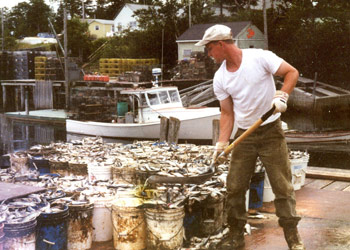Atlantic Herring
continued from June 2017 Homepage

The state of Maine relies on a regular supply of lobster bait, as do New Hampshire and Massachusetts. “There’s been a downplaying of the role of herring as forage, and even at times specifically to the one species of fishing I know a little about, the bluefin tuna.” – Steve Weiner, American Bluefin Tuna Association.
alternatives for public hearing at its September meeting.
At NEFMC’s April meeting, NEFMC member Michael Sissenwine questioned an analysis, performed with the available data to date, that concluded the herring isn’t important as a forage fish.
“There’s been a downplaying of the role of herring as forage, and even at times specifically to the one species of fishing I know a little about, the bluefin tuna,” said Steve Weiner of the American Bluefin Tuna Association. “Has that occurred and, if so, how concerned should I be that there isn’t a wide-enough range of alternatives that does factor in the possibility that herring is an important forage fish?…As someone who’s spent a lot of time on the ocean, it’s hard to believe.”
Deirdre Boelke, NEFMC’s fishery analyst for Atlantic herring, said the analysis shows that some predators may not have huge variations in terms of a response to different levels of herring abundance.
“It seems like there’s a whole bunch of alternatives on one side, and ones on the other side,” responded Weiner. “Should there be something more in the middle?”
Massachusetts recreational fishing advocate Patrick Paquette said that none of the parameters used to outline the fishery’s control rules seem to be ecosystem-based, nor do they seem to take into account socioeconomic factors outside of the direct-harvest herring fleet.
“We’re in the position of saying these results are informative relative to the fisheries, but not relative to forage,” said Sissenwine. Given the “hypothesis” that herring are important forage for predators—a hypothesis that hasn’t been rejected—“that leaves us with the scenario where we can make good use of these models in these management situations by acknowledging that we have to be cautious” with regard to predators, “even though we don’t know particularly which predators.”
“Assessing tradeoffs for this public resource has not been easy,” said EarthJustice attorney Erica Fuller, speaking on behalf of the Herring Alliance. Workshop participatns, she said, identified multiple ecosystem objectives and performance metrics that would achieve the objectives, with harvest controls would achieve a steady supply of catch for use as bait in the lobster industry, yet still maintain herring biomass in the water, with as few closures as possible. Seeking a high yield for the fishery but not for the ecosystem misses the point, she said.
“Everyone knows herring is important forage,” said Chris Weiner, a tuna fisherman from Portland and member of the Altantic Bluefin Tuna Association and CHOIR. “Our concern is, Tread carefully on the predator models….Anything that downplays herring as forage should be questionable.”
Among the measures under consideration to address localized depletion/user conflicts were the following:
• A June 1-Aug. 31 closure to all vessels and gear types fishing for herring within 6 nautical miles from shore in Area 114 (off the back of Cape Cod);
• A year-round prohibition on using midwater trawl gear in Area 1A;
• Three “buffer zone” proposals that would prohibit midwater trawl gear inside of 12, 25, and 50 nautical miles respectively in Areas 1B, 2, and 3 year-round from Cape Cod to the North/South Carolina border;
• A prohibition on midwater trawl gear year-round within five different 30-minute squares;
• Revert to original boundary line between Areas 1B and 3;
• Modify the Area 1B seasonal closure to open Jan. 1 instead of May 1.
NEFMC said it intended to maintain the current June-September prohibition on midwater trawling in Area 1A regardless of which options are chosen. Area 1A also is closed to directed fishing by all gear types from January through May.
Speakers objected to the idea of removing Area 2 from the midwater trawl gear prohibition alternatives.
“This option would leave Area 2 wide open,” said NEFMC member Mark Gibson. “I’m concerned about displacement of effort toward southern New England. That would disproportionately disadvantage the resource there.”
“I share that concern,” agreed NEFMC member Matthew McKenzie. “I think it does put undue burden on one part of the coast vis a vis another.”
NEFMC member Eric Reid said he shared that concern. But, he said, “since the fishery takes place mostly from Thanksgiving to February, March it’s never been an issue” from the local depletion angle. “And there’s no interaction with other user groups.”
NEFMC member Mark Alexander said he was concerned not only about user conflicts but about conflicts with other species, specifically river herring. “Connecticut has put tremendous resources toward restoring accessibility to habitat for river herring,” he said. “And to concentrate fishing in the place and time” when river herring are present in the ocean “is crazy. I know river herring aren’t the focus of this action, but it create problems.”
